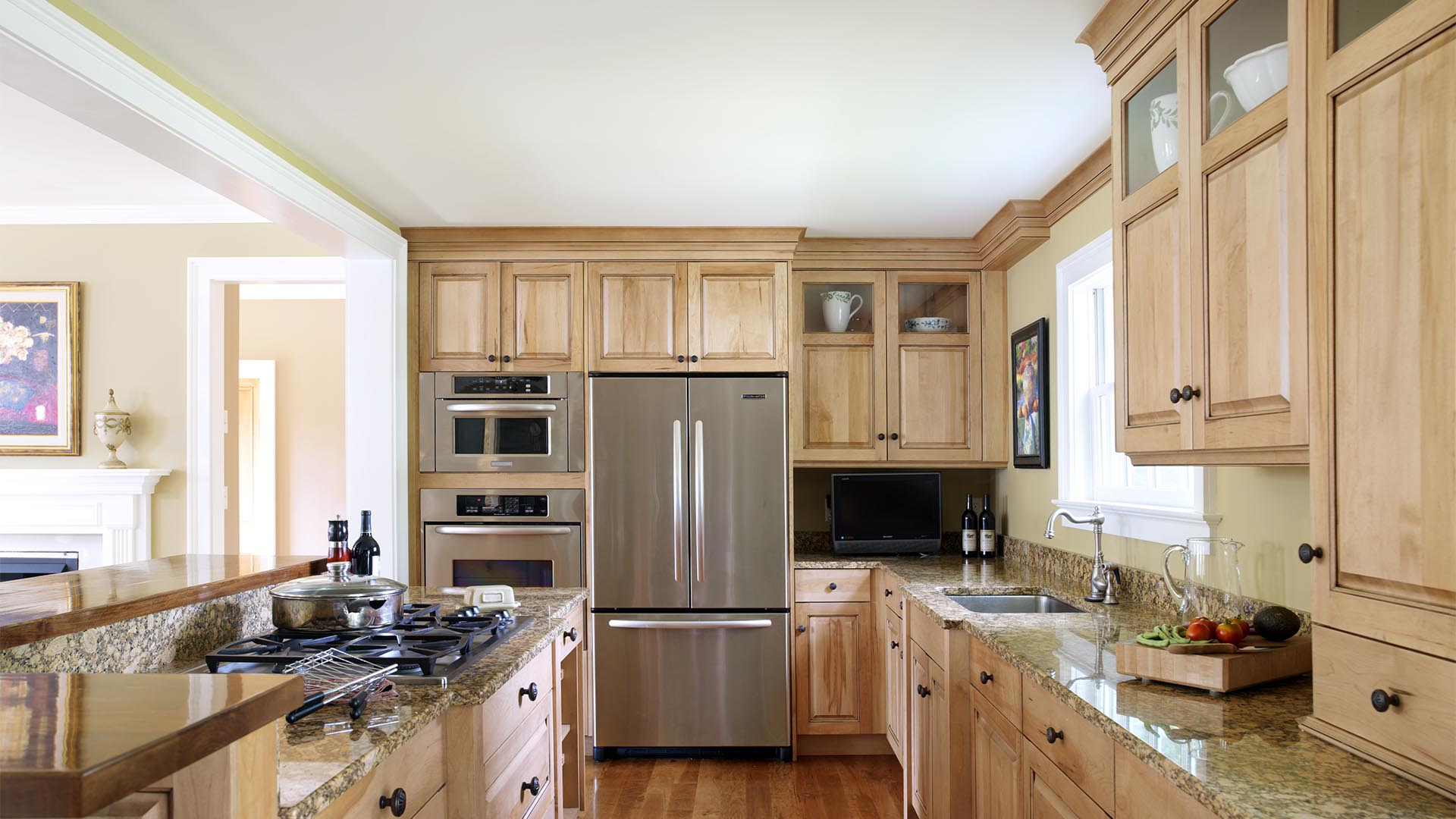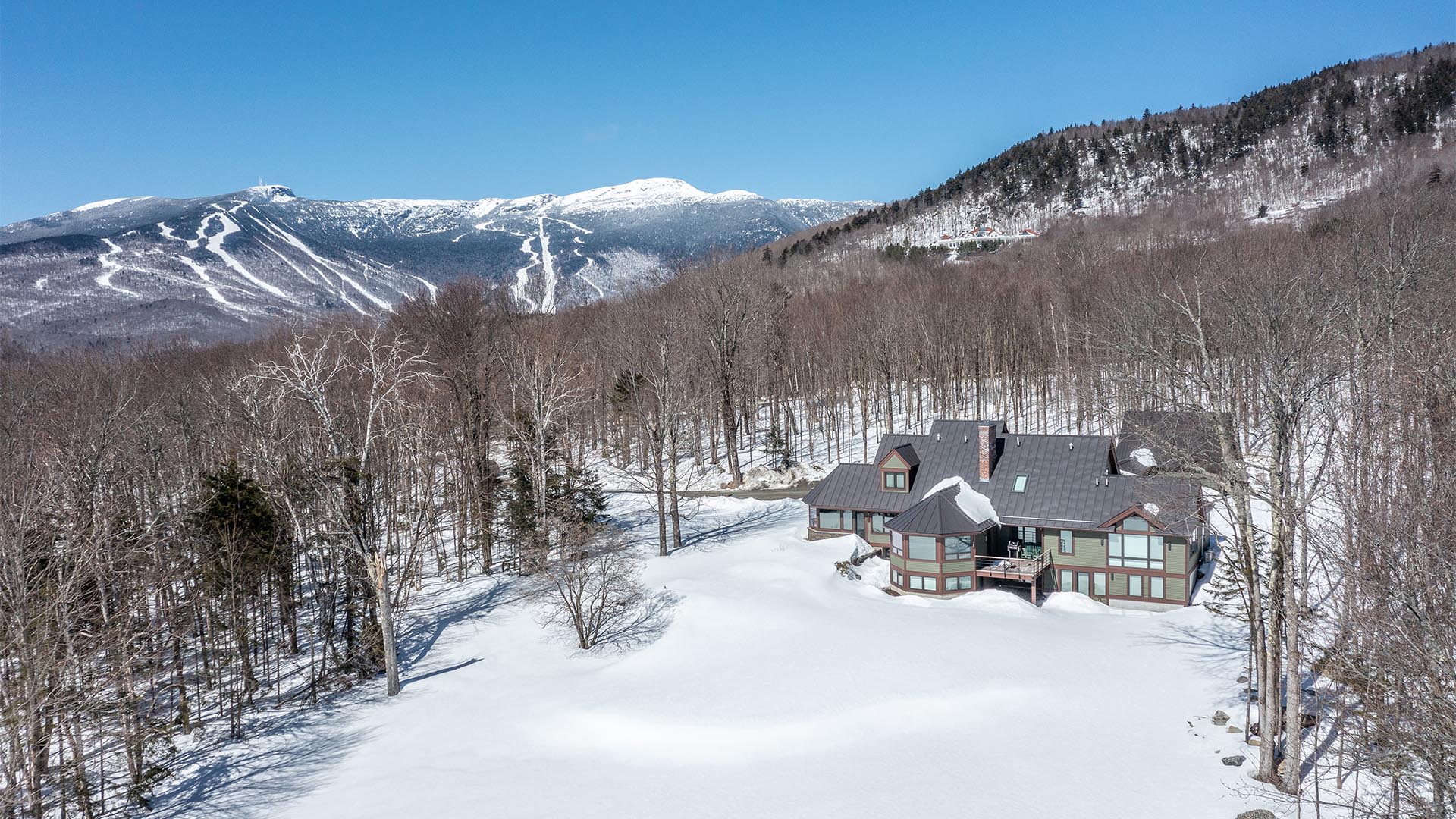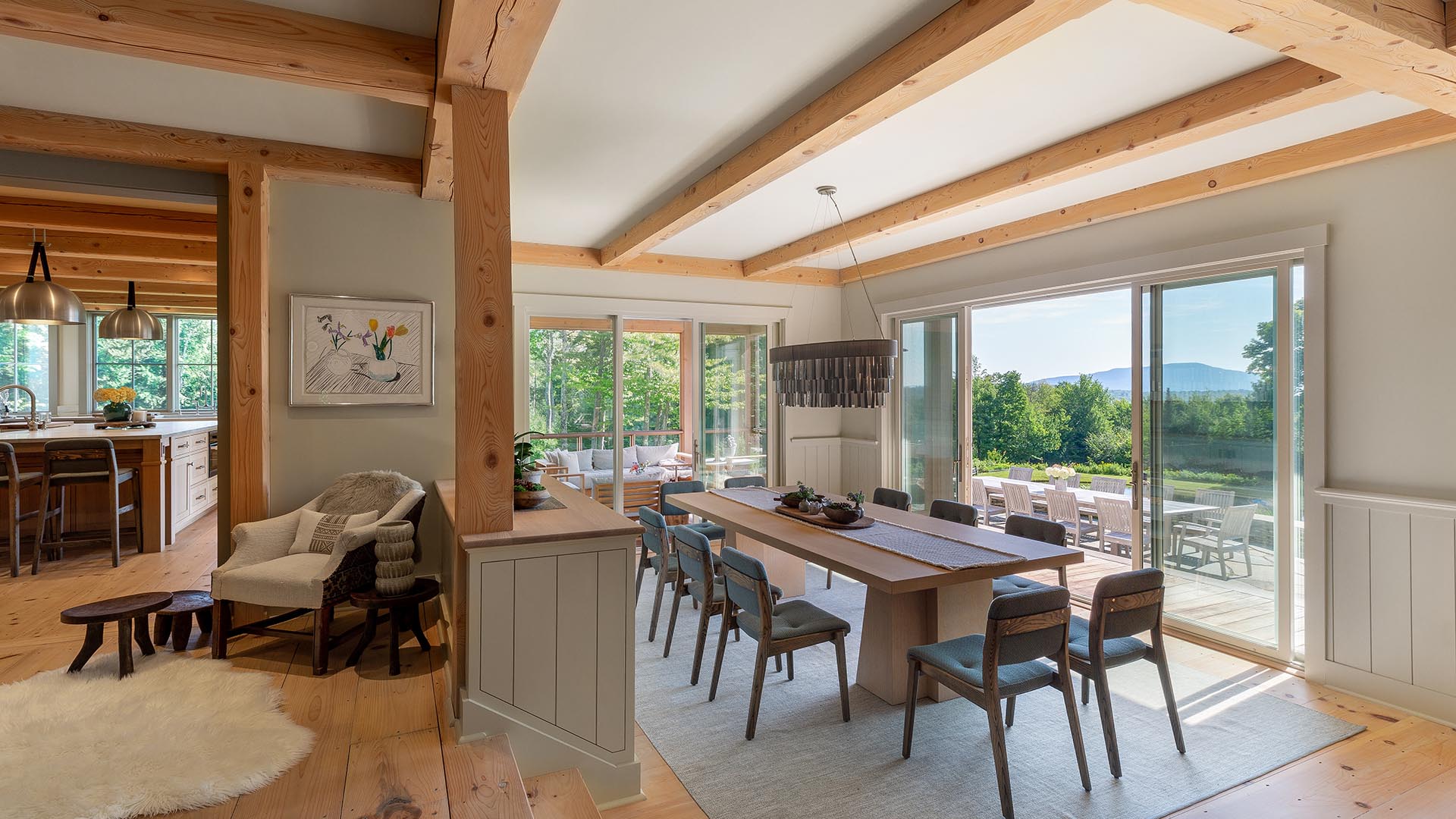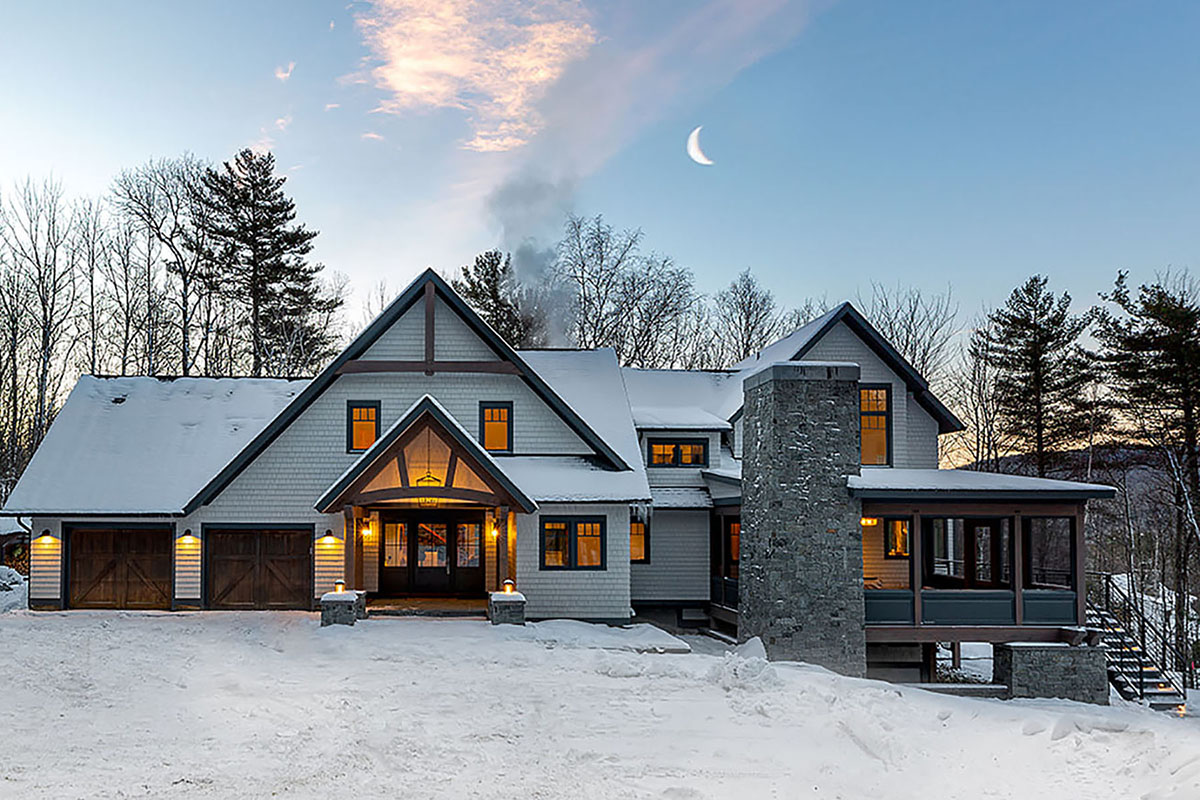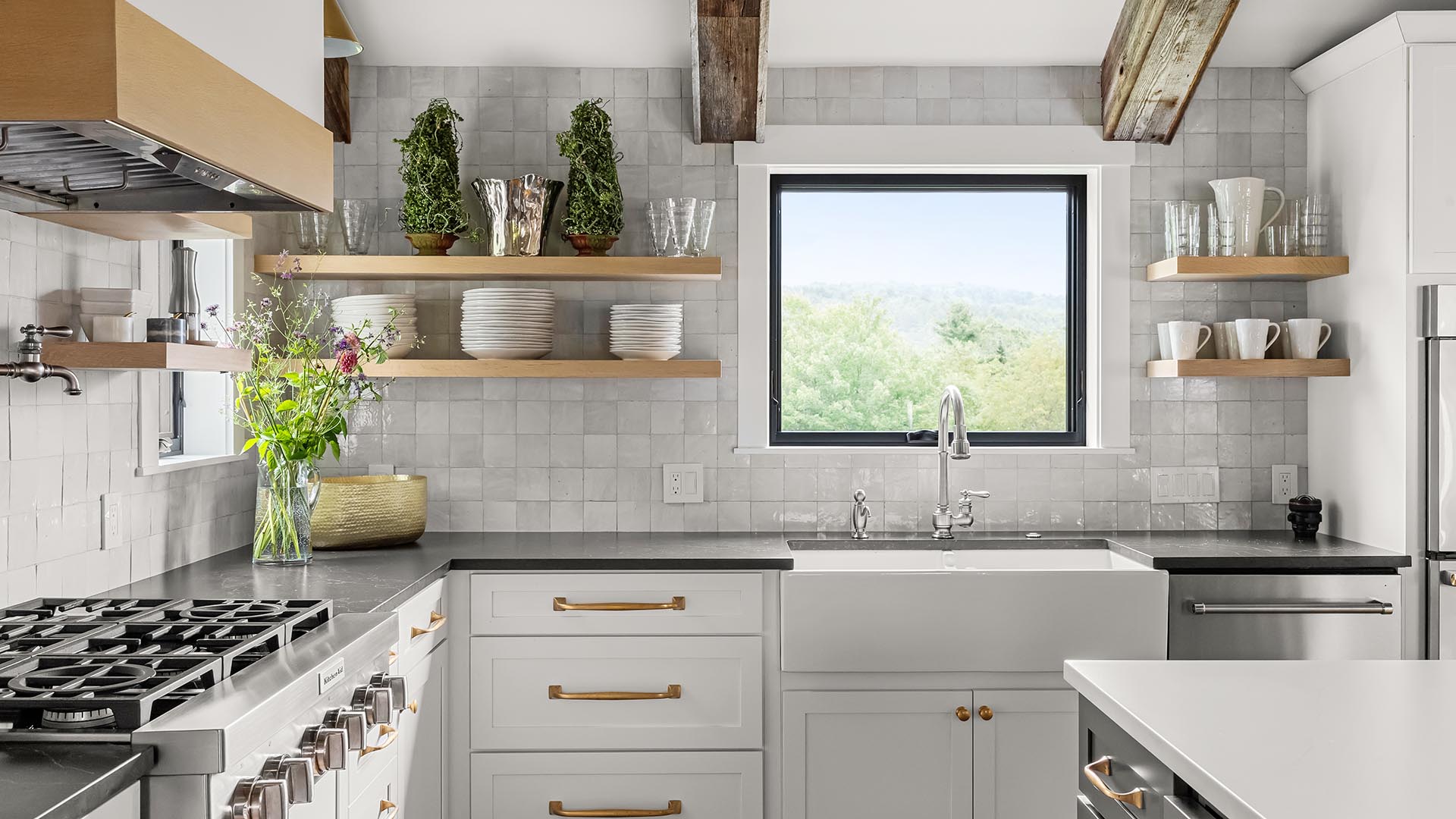An historic Stowe property undergoes an extensive renovation under the skillful direction of its owner
story by Elinor Earle • photos by Glen Callahan • Stowe Guide and Magazine – Winter/Spring, 2008-2009
By any standard, 181 Maple Street is a gorgeous property. Elegantly proportioned, Greek in revival detail, Vermont in farmhouse ambiance, it appears a quintessential mid-19th century village house. For nearly 158 years, this local landmark has stood as sentinel to Maple Street, once a magnificent alleyway of Vermont’s state tree that stretched a quarter of a mile before a hurricane took its toll in 1938. From its back porch, which resembles a classic southern veranda, splendid views spill over manicured lawns and gardens, mowed meadow and the meandering Lamoille River. All culminate in the silhouette of Mount Mansfield, a pastoral surprise given its central village location.
Like many of its neighbors, this jewel is listed on the National Register of Historic places, testament to endurance and perseverance, if not to authentic architectural pedigree. As with nearly every historic property in Stowe, convenience and practicality eventually trump authenticity. Long ago, the working barn attached to the rear of the house was converted into haphazard living space, now a magnificent master bedroom suite. Today, the classic front entrance, straddled by delicate sidelights and flanking pilasters, is primarily used only for special occasions. One in particular—All Hallows Eve—hosts over 500 goblins and annually serves as Halloween Command Central for Stowe’s trick or treaters.
Over the years Heron House (named in the late 1990s by finance Steve Chambers after the investment firm, Blue Heron Group) has seen nearly as many facelifts as it has known occupants and occupations. Variously, the property has been home to a family farm, doctor’s office, preschool nursery, private residence, international corporate headquarters, and an investment firm. The litany of owners includes some of Stowe’s founding families, prominent citizens and various characters of lore, among them—Lovejoy, Cady, Herrick, Raymond, Luce, Perry, Rudisill, and Larson. Present-day owner Lisa Hagerty follows in the footsteps of her sister, Anne Herrick, who owned the house in the 1990s with her husband Ted. Ironically, Stowe land records indicate another Herrick purchased the property in 1879. What comes around seems to go around with this house.
When it comes to exterior alterations, houses in the Stowe Village Historic District are held to strict criteria, including paint color, building material and adherence to architectural integrity. But what goes on under the covers is a different story, and in this case, the quiet exterior dignity of Heron House belies its sumptuous interior. Hagerty’s recent renovation has returned the house to its original use as a single-family dwelling.
“I fell in love with this house when my sister owned it years ago. We had many happy gatherings here over the years. When it came on the market, I had just finished building a new house, but I felt I had no choice. Its history and beauty called to me, she says. Working with local architect Bud Wilson, Hagerty set about to create an interior that would be inviting, sensitive to the historic character, and accommodate the constant flow of multiple family members and friends. When her son Chris, U.S. Snowboarding National Junior Men’s freestyle champion, and her daughter Kiley a senior at Gould Academy are home they now have a central place to hang out with mom while she’s cooking.
Stepping through the new, south-side entrance into what commonly would be considered the mudroom, the impression is both immediate and vivid. Hagerty’s interpretation of this essential Vermont room is nothing less than the triumph of imagination and artful design over the mundane. Welcoming the gracious, it sets the tone for what is to come.
Steps lead to a main hallway that opens onto the kitchen and Great Room, a term at historical odds with early farmhouses. Nevertheless, what was once a warren of small, dimly lit rooms, narrow doorways, low ceilings an irregular floors has morphed into light-filled, flowing space. The interior has been rejuvenated with impeccable taste, a masterful blend of traditional Vermont and, well, new Vermont.
Wilson recalls, “It was an incredibly chopped up and claustrophobic old farmhouse in the front with a spectacular office in the rear built by a previous owner. Lisa immediately saw the possibilities for the return to a single-family house, giving it a contemporary feel without disturbing the harmony of the original house. We gutted practically all of the first-floor farmhouse, raised ceilings added structural steel, installed in-floor radiant heat, moved the furnace and added a new kitchen.”
Builder Steve Sisler, whose firm oversaw the renovation agrees, “Lisa has a great instinct for finishes and materials and her vision took a totally dysfunctional space and opened it into the Great Room and kitchen. The project wasn’t without its surprises. We ran into asbestos at one point and a sheetrocked flue, as well. But it was exciting and rewarding, all the more so because of Lisa’s intuitive sense for design. It was Lisa’s idea to incorporate the original office storage space into a walk-in closet off the new master bath. She suggested keeping the shelves and using the filing drawers as built-in bureaus.”
The kitchen and Great Room area, the focal point of the renovation, is both intimate and expansive. On one side, the open kitchen stretches the length of the room, balanced by the dining and sitting area with its newly installed fireplace. “The creation of a kitchen/great room was the lynchpin of the renovation,” explains Hagerty. “Bud and I considered creating it in the back of the house, overlooking the Rec Path, or to the front, overlooking Main Street. In the end, we did what we originally knew wouldn’t be financially practical, we put it in the heart of the house, where I believed it belonged.”
To achieve this goal meant removing all of the center walls of the house, relocating the chimney and combining three spaces, the old kitchen, the dining room and a bedroom. The result is stunning with state-of-the-art appliances, granite and dark-wood counters, and a handsome island that provides a smooth transition between the kitchen and Great Room.
The Great Room floors are finished to imitate antique chestnut. “I am partial to wormy chestnut, but it’s hard to find and expensive,” says Hagerty. “So we chose knotty maple and mimicked the imperfections for chestnut with stain.” The effect is striking. Above, the handsome crown molding reflects her sentiment, “I am a trim nut.” She chose taupe for the walls, allowing for an infinite mix of fabrics and colors in the furnishings. “I love to mix and match like crazy”—the ultimate understatement.
Antiques from Hagerty’s past are at ease with the carefully chosen contemporary pieces. Artisan Trenny Robb, co-owner of High Beams in Sutton, Vt., designed the light fixtures throughout, including the magnificent wrought-iron chandelier over the dining table. The table, which easily can accommodate a dozen guests, bears the personality of an old New England tavern table, but in fact, is a reproduction. With the exceptions of the antiques, every piece of new furniture, every rug, and every decorative accessory was sourced from Vermont vendors.
“Vermont has so many incredible design resources. As a Vermont resident and local business owner, I feel it is important to help sustain our regional economy,” she says. “In the front hall, I selected a Colefax and Fowler wallpaper from a local design house. The colors in this pattern make my heart sing.” She says with a laugh. “Why go to New York when it’s all right here?”
Whenever possible, original architectural elements were recycled, such as the exquisite, narrow pine doors that now conceal front hall closets instead of the main living space. Many of the original, wide-pine floors were saved and returned to their former luster. While the bathrooms in the farmhouse section were modernized with reproduction fixtures, the upstairs bedrooms of the old farmhouse were left in their original configuration with wide pine floors, sloping ceilings, and 19th century charm heightened by select antiques, splendid bed linens, and colorful early American-style coverlets. Each bedroom bears the nameplate of a familiar Stowe landmark—Sterling, Mansfield, Sunset Rock, and Spruce—a touch added by Chamber and, in the spirit of historic succession, kept by Hagerty.
Heron House is bookended by two breathtaking rooms, the original farmhouse parlor, now the den, and the office, built by Hagerty’s brother-in-law in the 1990s, now the master bedroom suited. One of these alone would distinguish any property, but two are almost too much to contemplate. Hagerty subtly anchors these distant spaces by repeating the green of the den at the end of the long hallway leading to the master suite. Such attention to detail, evident throughout the house, contributes to its harmonious flow.
The paneled wall in the den is a replica of a wall found in Shelburne Museum’s 18th century Vermont House where feather-edged period boards from Vermont and New Hampshire houses were collected for the interior walls. As conceived by the museum’s founder, Electra Havemeyer Webb, the Vermont House interiors was reconstructed to portray the imagined home of a retired, wealthy sea captain.
Installing the wall was the inspiration of Janet Larson, who owned the house with her husband Ralph in the late 1980s. I fell in love with this painted, paneled room at the museum and the curator gave me and Mike Adams permission to copy it,” says Larson. “Mike built it piece by piece, and we added a fireplace to accommodate the original design. In the end, Ralph and I liked the rich honey color so much we couldn’t bear to paint it.”
Adams says, “The Shelburne wouldn’t allow us to take photographs or measure it, so I sketched for a few hours, probably on the back of a grocery bag. Originally, it was meant to be painted, so when it got to the fireplace curvature, I used little pieces of wood cut on angles and curled over, intending to fill it with putty and glue. I wasn’t very happy when Ralph told me they weren’t going to paint it, but everyone kept telling me how beautiful it was, so I’ve grown used to it. Working with wood is easy; all you need is a little imagination.
He could have added skill, as well. The delicately carved rosettes, perfectly matched panels, and detailed craftsmanship are evidence of a master woodworker. Today, a seminal oil painting of the Green Mountain Inn by local artist Rett Sturman hangs over the fireplace, a gift to Hagerty from her sister Anne. Ironically, the builder of the “brick hotel,” Peter Lovejoy, was related to Cornelius Lovejoy who owned the house in 1859, and one of Stowe’s fabled character, Parker Perry, once owned the inn and house simultaneously in the late 1950s.
At the other end of the hall and spectrum, in the early 1990s, Ted Herrick hired Mark Streuli and Robert “Mogey” Morgan with initial input from architectural designer, Milford Cushman, to create his corporate offices. In eight months, they constructed what has to be one of the most spectacular examples of contemporary American craftsmanship. Streuli, owner of Shutesville Builders, Inc., says, this was one of the most fun projects I ever worked on. Paul Larose out of Barre had been sitting on this beautiful cherry for years and he finally agreed to part with it. It is flame-grained and all the panels are book matched—millwork like this doesn’t come along every day.
“Mogey created the carvings for the fireplace as Ted was an avid fly fisherman and outdoorsman. The floors are red birch, which gives it its unusual color. One of the interesting effects is the color change as you move around; the light reflects differently. With its rich glow of cherry and exquisite carpentry work, this is a room equally suitable for a museum.
Hagerty wasted no time turning the office area into the master bedroom suite, adding a luxurious granite bathroom and walk-in closet. The bedroom flows into the private sitting area with its magnificent fireplace, complete with a mantle adorned with Morgan’s extraordinary hand-carved trout lunging for gold leaf flies. The floor parquetry is sensational.
As in the rest of the house, antiques mesh comfortably with contemporary furnishings—an exquisite 19th century, tip-top wine table perfectly complements the splendidly adorned, palatial master bed. While originally an indisputably masculine space, Hagerty has lent it a feminine touch through her selection of furniture, fabrics and decorative accessories.
Little in Hagerty’s professional background hints of her future passion for real estate and penchant for design. A Harvard graduate, she earned her MBA from Harvard Business School, then worked in New York City as an investment banker for years until becoming a full-time mother. But anyone who has visited Well Heeled, one of Stowe’s jazziest, upscale boutiques, knows she has a keen eye, a good sense of humor and incomparable taste.
As always, Hagerty gives credit where credit is due. “The project wouldn’t have been near as successful without Bud or Steve, or all the others who pitched in. Somehow, they were able to take my far-reaching concept for this historic farmhouse and translate it into an interesting, historically acceptable reality—not an easy thing to do. I am not an organizer by any stretch, just a doer, and am so blessed to have good, talented people to help me realize my vision.
With an abundance of creative ideas matched by seemingly inexhaustible energy, it seems doubtful Hagerty will rest on her laurels for long. But she insists she simply is savoring the present. She says, “I’m a real estate junkie, but I am happy where I am now.”
See more about this house on our website at Village Heron House.

